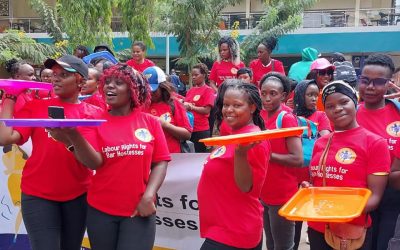DECEMBER 7TH 2021. BY BHESP TEAM.
BHESP, a sex worker-led organization has been at the forefront of advocating for the rights of sex workers since 1998. The organization working with other partners has witnessed different trends and development as well as challenges as it works to supports key population that are at the highest risk of contracting and spreading HIV.
According to the 2009 Modes of Transmission Study done by the National AIDS Council, UNAIDS and the World Bank, 14% of new HIV infections in Kenya occur among female sex workers and their clients. Data from BHESP shows an estimated HIV prevalence of 30% among female sex workers and their partners.
Daisy Kwala is a Care Manager with BHESP and she admits that it hasn’t been smooth sailing when it comes to providing care for HIV positive sex workers. “We currently have a cohort of 18,802 out of which 2151 are living with HIV, some of the major challenges around sex workers living with HIV are adherence to ART, most of them don’t keep appointment mostly influenced by alcohol and substance abuse, some don’t have shelter and operate from the hotspots so having them keep the ART at the hotspots is challenging” said Ms Kwala.
“Covid 19 has also affected sex workers living with HIV as it has interrupted Viral load uptake and commodities such as Anti-Retroviral Treatment (ART) drugs and condoms supply”, she added.
In efforts to enhance access to quality health care by female sex workers living with HIV, BHESP has provided Key Population (KP) friendly drop in centers for access to stigma free services for all, many innovations around service delivery for sex workers has been put in place such as BHESP purchasing motorcycles to help in timely reaching to PLHIV (Differentiated care model) to offer service such as psychosocial support, adherence and ART refills
BHESP has also trained peer navigators (sex workers living with HIV) that act as treatment supporters to the sex workers living with HIV at the community.
Peninah Mwangi, the Executive Director of BHESP acknowledges that there has been a lot of progress in terms of access to HIV care for sex workers in Kenya. “Previously sex workers were seen as vectors of disease, that has changed and even government now recognizes sex workers as part of the solution to curb HIV”, said Ms Mwangi. “Sex workers run their own clinics, do HIV outreaches which involves testing in bars, brothels and in their hotspots as well as distribution of thousands of condoms, she added.
Research from specialist HIV prevention and treatment clinics for female sex workers in Nairobi has found that the number testing positive for HIV dropped by more than two-thirds between 2008 and 2017. While no single intervention can be identified as to the underlying cause in the decreasing numbers, it suggests that increasing HIV awareness, testing and treatment in Kenya are reaching this population of women, despite sex work still being outlawed. It is estimated that female sex workers in Kenya are almost ten times more likely to contract HIV than non-sex workers, so they are a key population to target.
The national response to AIDS uses a public health approach to provide HIV services based on evidence. However, only a fraction of sex workers is reached. Fear of stigma and discrimination drive sex workers underground and makes it more difficult for them to access HIV prevention services.
Mary Nafula (not her real name) is a HIV positive sex worker who gets her medications and commodities from BHESP, she says she has never been so comfortable receiving services from BHESP, previously she was getting the services from a county government health facility. “If a sex worker goes into a hospital, she should be treated with dignity and respect, just like anyone else,” said Mary.
Poor interpersonal communication and even insults from health care providers together with inaccurate diagnoses are some of the problems that forced June Akinyi (not her real name), another HIV positive sex worker to move to BHESP. “At BHESP, you get friendly and willing to help care givers and the support group that I am engaged in offers different approaches to the challenges that we face as ex workers.
Two of the major strategies used for HIV prevention are HIV testing and condom use. Condom use increased significantly with both regular and casual partners. For HIV-negative female sex workers with regular partners in 2008, only 11% reported condom use all the time but by 2017, this had risen to 75%.
Some potentially important factors to explain the reduced prevalence have been suggested by researchers. The first is the improvement in HIV prevention messaging on a wide scale in Kenya for the entire population. The second factor could be higher rates of viral suppression in potential clients because of an increase in the use of antiretroviral therapy and the ‘treatment as prevention’ strategy. More specifically for female sex workers, the use of peer support to improve messaging to women not involved in clinics may also have contributed to the fall in HIV cases seen.
Given that the lifetime risk of HIV in female sex workers in Kenya is still high despite these decreasing numbers, research suggest that it is important to continue targeted interventions to further reduce infection rates of HIV.




